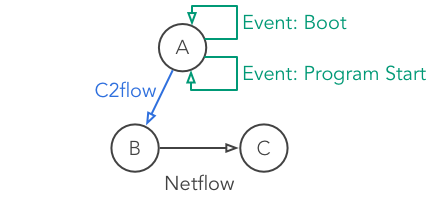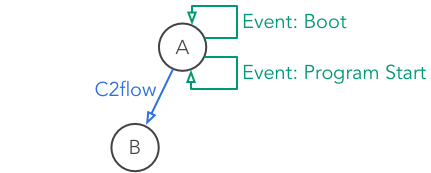4.2. Analyzing LANL Data using Advanced xGT Features¶
After learning how to use the basic functionality of xGT by following the Analyzing LANL Netflow Data with xGT notebook, you may wish to see some more advanced features and how to apply them to solving the same problem. This notebook demonstrates advanced techniques in the use of graph ideas as well as improved use of Python.
import xgt
conn = xgt.Connection()
conn.set_default_namespace('lanl')
conn
<xgt.connection.Connection at 0x7fc5fc7c6c10>
4.2.1. Establish Graph Schemas¶
We first try to retrieve the graph component schemas from xGT server. If that should fail, we create an empty component (vertex or edge frame) for the missing component.
try:
devices = conn.get_frame('Devices')
except xgt.XgtNameError:
devices = conn.create_vertex_frame(
name='Devices',
schema=[['device', xgt.TEXT]],
key='device')
devices
<xgt.graph.VertexFrame at 0x7fc5fd840c70>
try:
netflow = conn.get_frame('Netflow')
except xgt.XgtNameError:
netflow = conn.create_edge_frame(
name='Netflow',
schema=[['epoch_time', xgt.INT],
['duration', xgt.INT],
['src_device', xgt.TEXT],
['dst_device', xgt.TEXT],
['protocol', xgt.INT],
['src_port', xgt.INT],
['dst_port', xgt.INT],
['src_packets', xgt.INT],
['dst_packets', xgt.INT],
['src_bytes', xgt.INT],
['dst_bytes', xgt.INT]],
source=devices,
target=devices,
source_key='src_device',
target_key='dst_device')
netflow
<xgt.graph.EdgeFrame at 0x7fc5fd840790>
Edges: The LANL dataset contains two types of data: netflow and windows log events. Of the log events recorded, some describe events within a host/device (e.g., reboots), and some describe authentication events that may be between devices (e.g., login from device A to B). We’ll call the authentication events AuthEvents and the others we’ll call HostEvents. In this notebook we load only the Netflow data and HostEvents.
try:
host_events = conn.get_frame('HostEvents')
except xgt.XgtNameError:
host_events = conn.create_edge_frame(
name='HostEvents',
schema=[['epoch_time', xgt.INT],
['event_id', xgt.INT],
['log_host', xgt.TEXT],
['user_name', xgt.TEXT],
['domain_name', xgt.TEXT],
['logon_id', xgt.INT],
['process_name', xgt.TEXT],
['process_id', xgt.INT],
['parent_process_name', xgt.TEXT],
['parent_process_id', xgt.INT]],
source=devices,
target=devices,
source_key='log_host',
target_key='log_host')
host_events
<xgt.graph.EdgeFrame at 0x7fc5fd82acd0>
# Utility to print the data sizes currently in xGT
def print_data_summary():
print('Devices (vertices): {:,}'.format(devices.num_vertices))
print('Netflow (edges): {:,}'.format(netflow.num_edges))
print('Host Events (edges): {:,}'.format(host_events.num_edges))
print_data_summary()
Devices (vertices): 0
Netflow (edges): 0
Host Events (edges): 0
4.2.2. Load Data¶
We show how to load data only if the current data frames are empty.
%%time
if host_events.num_edges == 0:
urls = ["https://datasets.trovares.com/LANL/xgt/wls_day-02_1v.csv"]
host_events.load(urls)
CPU times: user 15 ms, sys: 2.88 ms, total: 17.9 ms
Wall time: 42 s
%%time
if netflow.num_edges == 0:
urls = ["https://datasets.trovares.com/LANL/xgt/nf_day-02.csv"]
netflow.load(urls)
CPU times: user 31.9 ms, sys: 18.2 ms, total: 50.1 ms
Wall time: 2min 12s
print_data_summary()
Devices (vertices): 31,324
Netflow (edges): 115,949,436
Host Events (edges): 16,781,773
4.2.3. Preprocess Graph¶
The LANL dataset consists of netflow edges whose direction is established using an algorithm that provides some consistency, but it is not based on the originator of the session as source as the destination of the session as the target.
Since this is the case, we first build a new edge frame containing all
command and control (C2) edges. We call the new frame C2Flow.
To construct the C2Flow edge frame we need to look through all
Netflow edges for records where either:
dst_port = 3128, in which case we copy the edge to theC2Flowframe verbatimsrc_port = 3128, in which case we “reverse” the edge (swap src_X and dst_X, for all of the directional fields) and insert that into theC2Flowframe
# Generate a new edge frame for holding only the C2 edges
conn.drop_frame('C2Flow')
c2flow = conn.create_edge_frame(
name='C2Flow',
schema=netflow.schema,
source=devices,
target=devices,
source_key='src_device',
target_key='dst_device')
c2flow
<xgt.graph.EdgeFrame at 0x7fc5fc7d8ee0>
4.2.3.1. Extract Forward and Reverse “Command-and-control” Edges¶
A “forward” edge is one where the dst_port = 3128. This edge is
copied verbatim to the C2Flow edge frame.
A “reverse” edge is one where the src_port = 3128. These edges are
copied to the C2Flow frame but reversed in transit. The reversal
process involves swapping the: src_device and dst_device;
src_port and dst_port; src_packets and dst_packets; and
src_bytes and dst_bytes.
import time
def run_query(query, table_name='Answers', show_query=False, parameters=None):
conn.drop_frame(table_name)
if query[-1] != '\n':
query += '\n'
query += 'INTO {}'.format(table_name)
if show_query:
print("Query:\n" + query)
start_time = time.time()
conn.wait_for_metrics()
wait_time = time.time() - start_time
if wait_time > 30:
print('Time to wait for metrics: {:3,.2f}'.format(wait_time))
job = conn.schedule_job(query, parameters = parameters)
print("Launched job {}".format(job.id))
conn.wait_for_job(job)
table = conn.get_frame(table_name)
return table
%%time
q = """
MATCH (v0)-[edge:Netflow]->(v1)
WHERE edge.dst_port=3128
CREATE (v0)-[e:C2Flow {epoch_time : edge.epoch_time,
duration : edge.duration, protocol : edge.protocol,
src_port : edge.src_port, dst_port : edge.dst_port,
src_packets : edge.src_packets, dst_packets : edge.dst_packets,
src_bytes : edge.src_bytes, dst_bytes : edge.dst_bytes}]->(v1)
RETURN count(*)
UNION ALL
MATCH (v0)-[edge:Netflow]->(v1)
WHERE edge.src_port=3128
CREATE (v1)-[e:C2Flow {epoch_time : edge.epoch_time,
duration : edge.duration, protocol : edge.protocol,
src_port : edge.dst_port, dst_port : edge.src_port,
src_packets : edge.dst_packets, dst_packets : edge.src_packets,
src_bytes : edge.dst_bytes, dst_bytes : edge.src_bytes}]->(v0)
RETURN count(*)
"""
r = run_query(q)
print('Number of rows: ' + str(len(r.get_data())))
print('Number of forward answers: ' + '{:,}'.format(r.get_data()[0][0]))
print('Number of reverse answers: ' + '{:,}'.format(r.get_data()[1][0]))
Launched job 39
Number of rows: 2
Number of forward answers: 18
Number of reverse answers: 1,337
CPU times: user 8.86 ms, sys: 0 ns, total: 8.86 ms
Wall time: 3.43 s
4.2.4. Querying Our Graph¶
We’ll be looking for a mock pattern, similar to one that might be used to detect bot-net behavior. The pattern reflects an infected host (a) which is connecting up to a bot-net command and control node (b) with an exfiltration connection to a collection node (c).

Zombie Reboot¶
Some device A boots up and, within a short amount of time, starts up a program.
Shortly afterwards, device A sends a message to some other device B.
Device B has a long-standing connection to another device C, which has been open for at least an hour, started before A booted, and remained open after A sent a message to B.
4.2.4.1. Query 1: Boot, Program Start, and Connection¶
We begin the pattern description with the boot and program start
events followed by a C2Flow edge from our preprocessing. We’ll
restrict it such that all the pieces (boot, program start, and C2 flow)
happen within 4 seconds.

Boot, Program Start, and Connection¶
%%time
q = """
MATCH (a)-[boot:HostEvents]->(a)-[program:HostEvents]->(a)
-[c2:C2Flow]->(b)
WHERE a <> b
AND boot.event_id = 4608
AND program.event_id = 4688
AND program.epoch_time >= boot.epoch_time
AND c2.epoch_time >= program.epoch_time
AND c2.epoch_time - boot.epoch_time < $max_time_window
RETURN count(*)
"""
# Note the overall time limit on the sequence of the three events
r = run_query(q, parameters = {'max_time_window':4})
print('Number of boot, programstart, & c2 events: ' + '{:,}'.format(r.get_data()[0][0]))
Launched job 65
Number of boot, programstart, & c2 events: 75
CPU times: user 5.14 ms, sys: 127 µs, total: 5.27 ms
Wall time: 286 ms
4.2.4.2. Query 2: Full Zombie Reboot Pattern¶
Finally, we add in the last network connection and match the full pattern.

Zombie Reboot¶
%%time
q = """
MATCH (a)-[boot:HostEvents]->(a)-[program:HostEvents]->(a)
-[c2:C2Flow]->(b)-[nf2:Netflow]->(c)
WHERE a <> b AND b <> c AND a <> c
AND boot.event_id = 4608
AND program.event_id = 4688
AND program.epoch_time >= boot.epoch_time
AND c2.epoch_time >= program.epoch_time
AND c2.epoch_time - boot.epoch_time < $max_time_window
AND nf2.duration >= $min_session_duration
AND nf2.epoch_time < boot.epoch_time
AND nf2.epoch_time + nf2.duration >= c2.epoch_time
RETURN count(*)
"""
r = run_query(q, parameters = {'max_time_window':4, 'min_session_duration':3600})
print('Number of zombie reboot events: ' + '{:,}'.format(r.get_data()[0][0]))
Launched job 67
Number of zombie reboot events: 11,850
CPU times: user 4.99 ms, sys: 1.55 ms, total: 6.54 ms
Wall time: 2.59 s